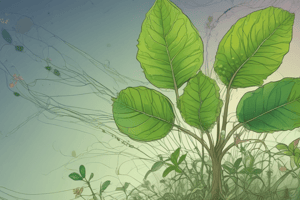Podcast
Questions and Answers
What is the main reason why plants lose a large quantity of water?
What is the main reason why plants lose a large quantity of water?
- To allow gas exchange during photosynthesis (correct)
- To maintain turgidity of cells
- To increase the surface area of the leaf
- To participate in hydrolysis of water molecules
What happens to the rate of transpiration when the temperature increases?
What happens to the rate of transpiration when the temperature increases?
- It increases because molecules move more rapidly (correct)
- It stops completely
- It decreases because molecules move more slowly
- It remains the same
Why does the rate of transpiration increase when the humidity is low?
Why does the rate of transpiration increase when the humidity is low?
- Because there is a low water potential gradient
- Because there is a low kinetic energy of molecules
- Because there is a high surface area of the leaf
- Because there is a high water potential gradient (correct)
What is the primary function of the xylem and phloem in plants?
What is the primary function of the xylem and phloem in plants?
What percentage of the water taken in by the roots is used for photosynthesis?
What percentage of the water taken in by the roots is used for photosynthesis?
What is the purpose of the remaining 1% of water taken in by the roots?
What is the purpose of the remaining 1% of water taken in by the roots?
How does wind speed affect the rate of transpiration?
How does wind speed affect the rate of transpiration?
Why is the surface area of the leaf an important factor in transpiration?
Why is the surface area of the leaf an important factor in transpiration?
What is the effect of a thicker cuticle on the rate of transpiration?
What is the effect of a thicker cuticle on the rate of transpiration?
What is the purpose of sunken stomata in xerophytes?
What is the purpose of sunken stomata in xerophytes?
Why do xerophytes have pale-coloured leaves?
Why do xerophytes have pale-coloured leaves?
What is the effect of rolled leaves on transpiration in xerophytes?
What is the effect of rolled leaves on transpiration in xerophytes?
What is the purpose of leaf hairs in xerophytes?
What is the purpose of leaf hairs in xerophytes?
What is the adaptation of stomata opening at night in xerophytes?
What is the adaptation of stomata opening at night in xerophytes?
What is the effect of waxy leaf cuticle on transpiration?
What is the effect of waxy leaf cuticle on transpiration?
What is the purpose of spines instead of leaves in xerophytes?
What is the purpose of spines instead of leaves in xerophytes?
Flashcards are hidden until you start studying
Study Notes
Transport in Plants
- In small organisms, osmosis, active transport, diffusion, endocytosis, and exocytosis are sufficient to provide nutrients and gases, but in larger organisms, cells may be too far apart for these processes to be adequate.
- Plants have developed two separate vascular systems: the xylem and the phloem.
Transpiration
- 90% of water taken in by roots is given off into the air as water vapor.
- The remaining 1% is used for:
- Photosynthesis
- Hydrolysis of water molecules
- Maintaining turgidity of cells
- Transport medium
- Cell elongation/increase in size
- The main reason for water loss is photosynthesis, which requires stomata to be open, leading to water vapor loss.
Factors Affecting Transpiration Rate
- Temperature: higher temperature increases transpiration rate due to faster molecular movement.
- Humidity: lower humidity increases transpiration rate due to a steeper water potential gradient.
- Surface area of the leaf: larger surface area increases transpiration rate.
- Draught/wind: increased wind speed increases transpiration rate by increasing water potential gradient.
- Light: stomata opens in light, leading to water loss.
- Number of stomata: more stomata increase transpiration rate.
- Cuticle: thicker cuticle decreases transpiration rate by preventing evaporation.
- Sunken stomata/stomata in pits: trapped moist air in pits increases humidity and slows down transpiration.
Xerophytes and Adaptations
- Xerophytes live in deserts or windy habitats with rapid evaporation.
- Adaptations include:
- Leaves reduced to spines with minimum surface area for transpiration.
- Reduced number of stomata to reduce transpiration rate.
- Rolled leaves, leaf hairs, and stomata sunk in pits to trap moist air and slow down transpiration.
- Waxy leaf cuticle impermeable to water.
- Reversed stomatal rhythm: stomata open at night and close at midday.
- Thick waxy cuticle reduces water loss and reflects heat.
- Pale colored leaves reflect solar radiation and do not heat up.
- Few stomata reduce water lost by transpiration.
- Examples of xerophytes include Marram grass and cactus, with adaptations such as rolled leaves, sunken stomata, fine hairs, and thick waxy cuticle.
Studying That Suits You
Use AI to generate personalized quizzes and flashcards to suit your learning preferences.




